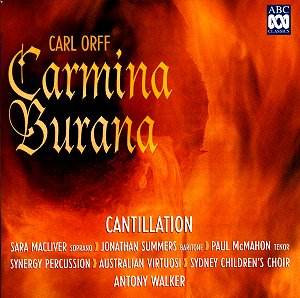Amateur choirs love Carmina Burana and itís not hard
to know why. Music as rhythmic as this is difficult to resist, the notes
themselves are not difficult to sing and there are quite a few opportunities
to have a good old shout. Itís not quite so satisfying, I think, from
the listenerís point of view. There are certainly passages where the musical
material is spread rather thinly, and one or two numbers where a verse
or two less would have been a good thing.
This recording from Australia is different from any
other I have heard in that the work is given in the composerís own reduced
version with accompaniment of two pianos and percussion. There are many
parts of the work where the piano and percussion sound are so much part
of the original version that we donít really miss the orchestra, and
indeed two of the numbers are identical in the two versions. But the
missing brass is a grievous loss in the final number of the Uf dem
anger section, Were diu werlt alle min, and itís sad not
to have, amongst other things, the soothing (or seductive) sound of
the strings as they support the soprano soloist.
Whether or not the choice of version is important to
you, what is indisputable is that this is a relatively small-scale performance.
There are forty-three names listed as members of the choir, Cantillation,
but there are only twenty of them on the accompanying photograph and
the group sounds more like twenty strong than forty-three to me. Even
recorded fairly closely, as here, there is inevitably a loss of sheer
weight when compared to recordings with orchestra. Carl Rosman, in the
accompanying note, tries to argue that the composer may well have preferred
this approach. Others may find his evidence more convincing than I do,
just as they may require more than "utterly straightforward, diatonic
melodies" to justify the claim that Orff was influenced by Monteverdi
in this work. Reduced scale or not, the choir is obviously a capable
group and sings the work extremely well, and given their small number
and trained voices they are able to avoid many of the intonation problems
to which amateur choirs are sometimes prone, particularly in high lying,
quiet passages for womenís voices. The Sydney Childrenís Choir likewise
puts on a good show, with excellent intonation again a feature. A glance
at the photo and list of members confirms, however, what listening to
them seems to suggest: that classical music amongst the young is rapidly
becoming an activity more and more limited to girls. The accompanying
pianists and percussionist are excellent.
The famous roasted swanís aria is taken by a tenor,
and very well he sings it too, though others have made it more grotesque
whilst at the same time making us feel sorry for the beast. Sara Macliverís
extremely clear and pure voice is well suited to the work and her arrival
banishes the dark and rather foetid atmosphere of much that has gone
before. Her stratospheric Dulcissime is beautifully done, so
I find it a pity that singing not quite in the centre of the note mars
my favourite number in the whole work, In trutina. The best of
the soloists is Jonathan Summers. His singing is everywhere distinguished
by a scrupulous attention to the text. He is excellent as the bibulous
abbot, and his singing of Dies, nox et omnia creates a quite
extraordinary sense of calm.
The conductor, Antony Walker, keeps everything well
under control. In the identical opening and closing choruses he chooses
to push the tempo forward at the moment the music suddenly becomes louder.
Iíve never heard this done to this extent before and donít find it very
effective.
Some years ago I sang in a series of Carminas in
Toulouse conducted by Michel Plasson. The performances were far from
perfect but there was a wildness about them, a raw edge, a lack of inappropriate
refinement, all of which was very convincing, at least from inside the
choir. Something of his approach is preserved in his EMI recording with
the Catalan choir Orféon Donostiarra, but there is very little
of it in this Australian performance. The men are very sober as they
bewail the poor abbotís fate, and when everyone sings "I am bursting
all over! I am bursting all over with first love!" Iím afraid we
just donít believe them.
The recording is fine, but with a few strange perspectives
from time to time. The baritone soloist, in particular, seems to wander
about a bit. And then in the seconds before the music starts we hear,
in the left channel, a background hum as if something is not properly
earthed. It is often barely audible, and in loud passages is not a problem
in any case. It would be more of a nuisance through headphones, but
whichever your preferred mode of listening I think you would find it
troublesome in the many silences which punctuate, for example, the solo
soprano and childrenís song Amor volat undique.
William Hedley


